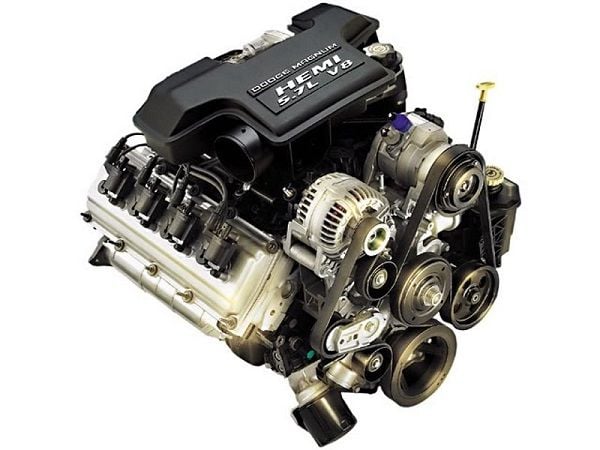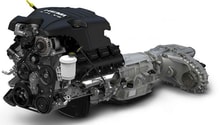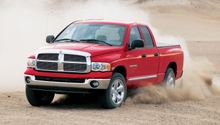Dodge Ram 2002-2008: 4.7L vs. 5.7L Hemi Engine Difference
For the third generation Dodge Ram, two different 8-cylinder engine choices are available. The larger displacement of the two being the 5.7 liter Hemi. The 4.7 liter has its advantages also, with its slightly better gas mileage and generally cheaper retail price.
This article applies to the Dodge Ram 3rd Generation (2002-2008).
Choosing which 8-cylinder engine is best for your needs will come down to several critical aspects. The 5.7 Hemi engine has substantially more horsepower and torque, while a Ram with a 4.7 engine can typically be purchased for less. For those that will be doing a lot of towing, the Hemi will suit your needs best with its almost doubled towing capacity over the 4.7 engine. Transmission options are limited to one for the 5.7 being a 5-speed automatic, while the 4.7 can be found with an automatic and manual. Both engines come with two-wheel drive and four-wheel drive.
Component Breakdown
5.7 Hemi Engine
The 5.7 liter Hemi engine is rated at 345 horsepower and 375 ft. lb. of torque. It accelerates the Ram from 0-60 in seven seconds. In 2004, this engine in a regular cab Ram was rated at 13 mpg city and 17 hwy. The 2005 and onward engines received a cylinder deactivation feature, increasing mpg to three on the highway and four in the city. The towing capacity is rated between 8,000 to 9,000 lbs. depending on wheel size, bed length, and axle ratio. The transmission mated to this engine is the 545RFE (a 5-speed automatic).

Magnum 4.7 Engine
The 4.7 engine is rated at 235 horsepower and 295 ft. lb. of torque. These numbers changed in 2008 when it was updated to 310 hp and 330 ft. lbs. of torque. Gas mileage has been found to average 14 mpg city and 19 mpg highway. The tow capacity ranges from 4,500 to 5,700 lbs. Owners looking for a manual transmission are limited to this engine. The NV3500 5-speed was offered until 2005 when it was replaced with a Getrag 238 6-speed. The 2002 model years were equipped with the 45RFE 4-speed automatic. 2003 to 2008's were optioned with the 545RFE 5-speed automatic. This engine is also offered in flex-fuel versions (E85 compatible).

Scheduled Maintenance
Refer to the Related Article: Engine Maintenance for the scheduled maintenance.
A copy of your owner's manual can be downloaded from the Ram's website.
Common Questions
What Octane of Gasoline Does Each Engine Need?
The 4.7 liter engine uses 87 octane. The 5.7 states 89 octane is the preferred grade. If you are towing, or driving the car under harsh conditions, consider using a higher octane fuel to combat any potential engine knock issues that can occur when putting the engine under a lot of load.
Which Engine Will Last Longer?
The biggest factor in determining the engines lifespan is whether maintenance has been performed in a timely manner. Owners have verified both engines are capable of seeing over 200,000 miles. Some owners experience head gasket failures with their 4.7's when overheated, which is said to be caused by the inefficient coolant passage design.
Which Engines Replacement Parts Cost More?
Generally, the Hemi engines replacement parts will be slightly more expensive than the 4.7's. For example, a starter for the 5.7 averages close to $200, while a 4.7's starter averages close to $100.
How Much More Will it Cost to Buy a Ram Equipped with the Hemi?
According to Kelley Blue Book, a 2005 Dodge Ram with 5.7 is worth $800 more than the same truck with a 4.7.
Common Issues
4.7 Magnum Engine Sludge Buildup
This problem is most prevalent on engines with over 100,000 miles. Some owners believe this engine is more prone to sludge buildup than the 5.7. Following the oil change interval and using good quality oil as well as filters will greatly reduce the risk of sludge buildup.
5.7 Hemi Broken Valve Springs
Engines not equipped with the cylinder deactivating feature are installed with valve springs, which were later updated to a new design found on the Hemi engines with cylinder deactivation. There may be a defect with the originally designed springs, leading to breakage and potentially severe engine damage; although, these instances are isolated.
Technical Service Bulletins (TSB)
- Refer to the Related Article: Engine Maintenance for the list of TSB.
Related Discussions
- 4.7L vs. 5.7L - DodgeForum.com
- 5.7 Hemi vs. 4.7 Ram - DodgeForum.com
- Towing Capabilities of 1500 Ram - DodgeForum.com






